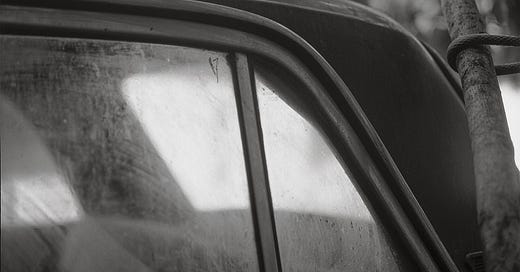There are tools - not objects, but tools a person can pine for, waiting patiently for the right one to present itself at the right price, from the right seller. Beyond superstition and a lot of “New Yorkers never pay full price” logic, the days become years for me, even decades, until that kismet moment arrives.
It was the middle of a hectic night, revising animations for more than one client at the same time. The files were copying, and uploading and I somehow checked eBay, on that eternal search for the right model Rolleiflex, a camera made in Braunschweig Germany, specifically one with a Zeiss Planar 2.8 lens made in 1955, a 2.8D. This model is the sweet spot, with so many variations on this camera to mull over, some worth upwards of $4k, and some as low as $400 and a cornucopia of options inbetween. A Rolleiflex is the camera Vivian Maier used, and Diane Arbus, Lee Miller, and so many more.
And then, that exact model I was after stared back at me, cleaned and checked and in perfect working order for a terribly good price. I bought it, without another thought and waited a few weeks for it to arrive.
The first thing you do in these situations is to run a roll of film through it. I took pictures of an old car that has been parked under a tree for years, just downstairs from us. The tires are dead flat, the windows are cracked, the dashboard is caked with dust. A tree grows over it in summer, hiding almost all of it, and in winter, it sits like a dinosaur of Soviet times, the Jiguli someone cannot bear to part with.
I began to think about the hands that made this camera in West Germany, if they were hungover that day, or if it was their child’s birthday when they turned the last screws on the body. And then it was boxed and shipped to some camera store in Japan, or Paris or Madrid, or Cincinnati. No one knows. It sat on a shelf and someone spied it, glistening and new, planning to take scrumptious pictures on a honeymoon at Niagara Falls, or on the beach in Cannes, or in some osteria in Tuscany. They bought it to nail down the important moments, and maybe some of the quiet ones inbetween too. They bought Kodachrome, or Tri-X, or Agfa, loading the camera in rapt silence, under one roller, over the next, advancing the film until the arrow on the paper presented itself, snapping the door shut like they had just robbed the bank, and twisting the little lock button on the bottom. Next, advancing the film until the little number “1” pops up in a little window, and now there are twelve square frames to shoot of anything and everything their heart desires. This is the ultimate freedom, in a little box. A picture of a child building a city from wood blocks, or a familiar view outside a window, a naked lover in recline, an old pair of hands, a fish freshly caught, a horse in a field, a mother, a father, a neighbor. Measuring the light, setting the shutter, focusing on that square that shines so bright, the gentle click of the shutter, and then remembering to advance to the next frame, ready for whatever comes next.
And then someone sold it, or someone died and passed it on to a niece or a nephew, or just to someone that needed this camera. It has more stories to witness with a silent, unblinking eye, passed from one hand to the next, but obviously taken care of. There are no scratches, no heavy wear on the knobs or the leather, this camera was cherished by every owner.
I imagine it sat in a drawer or an attic for some time, tight in a chest, safe from dust. Maybe someone meant to use it, but got sidetracked, like that abandoned car downstairs, waiting to be fixed, knowing all too well that day may never come.
My friend Stella says that guitars remember when they were just trees (please forgive me for screwing up the words if my paraphrasing is off). So - do cameras remember when they were just a chunk of metal, some screws, some springs and carefully polished glass? They cannot tell us their dreams, but if you feel like humoring me, imagine that they do talk. In our hands, they send secret encouragement to us, their new owners. They root for us, running shotgun on one more advenvture - this camera made some 70 years ago, ready for more.
The Rolleiflex years are coming now that I hold this tool in my hands.
Film stock is ordered. A plan unfolds - what this camera was meant to shoot, and why. The recipe writes itself, now that the ingredients are finally in the kitchen.






"I really believe there are things nobody would see if I didn't photograph them." - Diane Arbus, American photographer.
I wonder if that camera remembers all the pictures it already took? And incidentally, I recently bought a little book of Vivian Maier photographs, so I can't wait to see what you'll capture with that same model of camera.